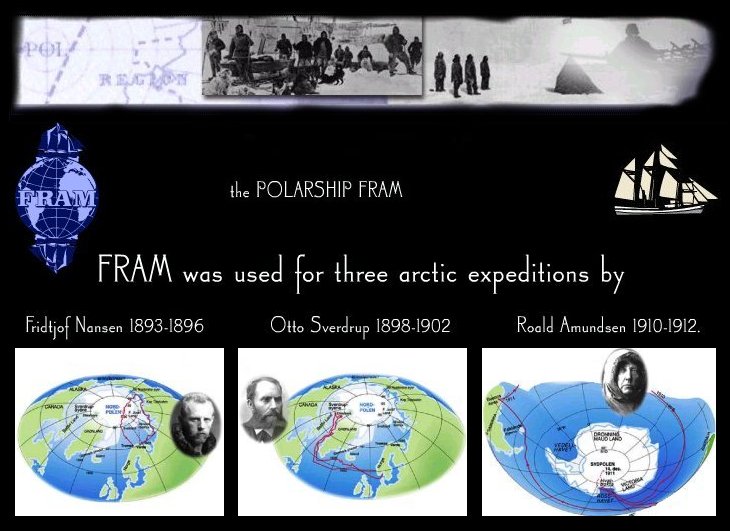
The Norwegian Fridtjof
Nansen developed a theory, based on his Artic field-research, that there
must be a current somewhere between the North Pole and Franz Josef Land
from the Siberian Arctic Ocean toward the coast of Greenland. There had to
be a navigable passage between the seas east of Greenland and north of
Asia. His theory was that the driftice finds its way across the unknown
Arctic Ocean through this open link. Nansen believed that on the same ice
it ought to be possible to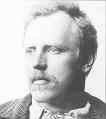 bring an expedition along the same route.
bring an expedition along the same route.
His plan met not only with strong objections but also as nearly unanimous condemnation. To date no one had willingly gone into the ice, and many of the vessels which had been caught in the ice had been crushed by its pressure.
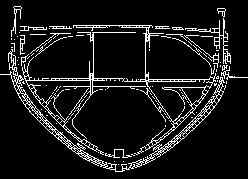 The
die, however, were cast and the only question remaining was who could
build a vessel according to Nansen's specifications. The choice was
obvious: Colin Archer, Norway's foremost builder of wooden-hulled ships,
became the order to build the world's strongest vessel. Archer was
convinced that an upright-sided hull, even if made of steel, would not be
strong enough to withstand the pressure of the pack ice. The hull (39 x 11
mtr.) was therefore constructed of Italian oak with rounded sides and
bottom. A cross-section of the ship bore a close resemblance to a coconut
shell with its top half missing. The purpose of the design was to enable
the ship to rise on top of the ice as it is pressed against her sides, and
thus avoid being crushed. The topsail schooner FRAM was launched on 26
October 1892.
The
die, however, were cast and the only question remaining was who could
build a vessel according to Nansen's specifications. The choice was
obvious: Colin Archer, Norway's foremost builder of wooden-hulled ships,
became the order to build the world's strongest vessel. Archer was
convinced that an upright-sided hull, even if made of steel, would not be
strong enough to withstand the pressure of the pack ice. The hull (39 x 11
mtr.) was therefore constructed of Italian oak with rounded sides and
bottom. A cross-section of the ship bore a close resemblance to a coconut
shell with its top half missing. The purpose of the design was to enable
the ship to rise on top of the ice as it is pressed against her sides, and
thus avoid being crushed. The topsail schooner FRAM was launched on 26
October 1892.
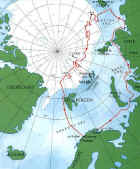 FRAM
embarked on her fabled voyage on Midsummer's Day, 24 June 1893. On the 22
September 1894 in the vicinity of the New Siberian Islands FRAM was forced
to a final halt and was caught in the ice. The drift, however, did not go
in one fixed direction as Nansen had predicted. Instead, the FRAM drifted
in the right direction for a few days, only to backtrack to her point of
departure. Often there was no progress at all for several weeks, driving
Nansen and the crew to distraction. His theory had been dealt a serious
blow. It was generally assumed that the Arctic Ocean was a shallow body of
water, possibly with a mainland at some point. As the crew took regular
soundings of the sea bottom, the measurements indeed pointed to a shallow
polar basin, but this was only true initially. As the drift took the FRAM
away from the coast, the waters increased in depth. When the bottom fell
away to 4000 fathoms, and the sounding line could be lengthened no more,
Nansen admitted that his theory of the current was not as valid as he had
thought. Giving the enormous volumes of water in the Arctic Ocean, the
supply emanating from the Gulf Stream and the Siberian rivers could only
have a minimal effect on the current. Nevertheless, the drift did flow to
the north and west.
FRAM
embarked on her fabled voyage on Midsummer's Day, 24 June 1893. On the 22
September 1894 in the vicinity of the New Siberian Islands FRAM was forced
to a final halt and was caught in the ice. The drift, however, did not go
in one fixed direction as Nansen had predicted. Instead, the FRAM drifted
in the right direction for a few days, only to backtrack to her point of
departure. Often there was no progress at all for several weeks, driving
Nansen and the crew to distraction. His theory had been dealt a serious
blow. It was generally assumed that the Arctic Ocean was a shallow body of
water, possibly with a mainland at some point. As the crew took regular
soundings of the sea bottom, the measurements indeed pointed to a shallow
polar basin, but this was only true initially. As the drift took the FRAM
away from the coast, the waters increased in depth. When the bottom fell
away to 4000 fathoms, and the sounding line could be lengthened no more,
Nansen admitted that his theory of the current was not as valid as he had
thought. Giving the enormous volumes of water in the Arctic Ocean, the
supply emanating from the Gulf Stream and the Siberian rivers could only
have a minimal effect on the current. Nevertheless, the drift did flow to
the north and west.
 FRAM
proved to be really able to withstand the ice pressure. She was been
pressed upwards by the constant collisions, and the voyage continued with
the ship and her crew travelling on the ice. Everyday life aboard the ship
consisted of gathering scientific data, hunting and tending to the dogs.
The crew made skis, sledges and kayaks. They were keenly interested in the
drift and its direction. Holes were drilled in the ice and by watching the
lines who were dropped into the
FRAM
proved to be really able to withstand the ice pressure. She was been
pressed upwards by the constant collisions, and the voyage continued with
the ship and her crew travelling on the ice. Everyday life aboard the ship
consisted of gathering scientific data, hunting and tending to the dogs.
The crew made skis, sledges and kayaks. They were keenly interested in the
drift and its direction. Holes were drilled in the ice and by watching the
lines who were dropped into the m
the men could judge the direction in which the vessel was drifting. But,
as 1893 ebbed out, the drift continued to be unsatisfactory. Nansen was
not the most popular member of the expedition. Prone to depressions, he
was a difficult man to deal with. Finding it hard to contain his
frustration, he calculated that given the nature of the drift, they might
spent anywhere from five to eight years in the ice.
m
the men could judge the direction in which the vessel was drifting. But,
as 1893 ebbed out, the drift continued to be unsatisfactory. Nansen was
not the most popular member of the expedition. Prone to depressions, he
was a difficult man to deal with. Finding it hard to contain his
frustration, he calculated that given the nature of the drift, they might
spent anywhere from five to eight years in the ice.
 During
the first half year of 1894 the drift continued in a westward direction
and Nansen now arrived at the conclusion that the drift would definitely
last for three years. He was no longer in doubt that the expedition would
ultimately succeed, but believed that the FRAM was unlikely to drift
higher than 85ºN. He decided that he was not prepared to give up the
Pole. He decided to leave the ship and together with Hjalmar Johansen
strike out for the Polar Point on skis and by sledge, with kayaks for the
open water spots. Shipmaster Otto Sverdrup was instructed to lead the
expedition further and to bring the FRAM safely back to Norway. When
Nansen and Johansen left the FRAM they had provisions for 100 days.
During
the first half year of 1894 the drift continued in a westward direction
and Nansen now arrived at the conclusion that the drift would definitely
last for three years. He was no longer in doubt that the expedition would
ultimately succeed, but believed that the FRAM was unlikely to drift
higher than 85ºN. He decided that he was not prepared to give up the
Pole. He decided to leave the ship and together with Hjalmar Johansen
strike out for the Polar Point on skis and by sledge, with kayaks for the
open water spots. Shipmaster Otto Sverdrup was instructed to lead the
expedition further and to bring the FRAM safely back to Norway. When
Nansen and Johansen left the FRAM they had provisions for 100 days.
 What
followed was an incredible journey of 462 days, first eating their dogs
and then living off the land, particularly polar bear, walrus and seals.
They never reached the Pole and survived the winter at Franz Josef Land.
They made a six sq.m hut with stone and moss. A large log of driftwood
became a ridge beam, over which they stretched two walrus skins for a
roof. A bear skin was used for the entrance door.
What
followed was an incredible journey of 462 days, first eating their dogs
and then living off the land, particularly polar bear, walrus and seals.
They never reached the Pole and survived the winter at Franz Josef Land.
They made a six sq.m hut with stone and moss. A large log of driftwood
became a ridge beam, over which they stretched two walrus skins for a
roof. A bear skin was used for the entrance door.
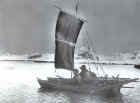 In
the next spring they made a makeshift catamaran of their two kayaks. They
travelled harnessed to their ski-runnered sledges, at times paddling or
sailing the two lashed kayaks. By accident they met the British polar
Frederick G. Jackson and with his expedition vessel “Windward” they
arrived in Vardø on the 13th August 1896.
In
the next spring they made a makeshift catamaran of their two kayaks. They
travelled harnessed to their ski-runnered sledges, at times paddling or
sailing the two lashed kayaks. By accident they met the British polar
Frederick G. Jackson and with his expedition vessel “Windward” they
arrived in Vardø on the 13th August 1896.
On the same day the FRAM freed itself from the grip of the ice around Svalbard (Spitsbergen), having spent 1056 days in its clutches. On 20 August she entered Skjervøy Harbour where Sverdrup learned that Nansen had reached Vardø. Sverdrup immediately set sail for Tromsø, where Nansen and Johansen came on board, and the original crew was once again complete. The voyage had been completed and its accomplishments were viewed by everyone as remarkable. What followed was a triumphal cruise along the coast from Norway and the FRAM expedition was viewed as a zenith in the annals of exploration.
This first FRAM expedition
had been an overwhelming success, its fame reverberating well beyond
Norway's borders. Consul Axel Heiberg and the two founders of the Ringnes
Brewery, Amund and Ellef Ringnes, where therefore willing to equip the
FRAM for a new voyage of discovery. The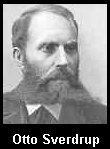 y
formed the FRAM Shipping Company, leasing the vessel from the government.
Since the first FRAM Expedition had yielded a prodigious quantity of
scientific material which needed to be processed and evaluated, Nansen was
unable to participate in the journey. However, a plan for the expedition
began to evolve, calling for the vessel to penetrate as far as possible,
in order to investigate the “white spots” on the map of Greenland's
northern and western coasts. Once again, Nansen asked Otto Sverdrup to be
de leader of this expedition.
y
formed the FRAM Shipping Company, leasing the vessel from the government.
Since the first FRAM Expedition had yielded a prodigious quantity of
scientific material which needed to be processed and evaluated, Nansen was
unable to participate in the journey. However, a plan for the expedition
began to evolve, calling for the vessel to penetrate as far as possible,
in order to investigate the “white spots” on the map of Greenland's
northern and western coasts. Once again, Nansen asked Otto Sverdrup to be
de leader of this expedition.
The second FRAM Expedition lasted for four years and ran into formidable hurdles of a magnitude which put both the crew and ship in harm's way. There were 6 scientists on board for mapping and investigation the region in the northwest of Greenland. They spent their first winter in a well-sheltered inlet in the northern section of Rice Strait and christened it Frams Havn (Frams Harbor).
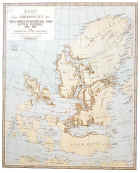 The
expedition was a complete success, charting and discovering between
150.000 and 200.000 sq.km of land. The maps drawn by Lt. Gunmar Isachsen
show 250 sites in the Canadian Arctic bearing Norwegian names, some of
which are both descriptive and most likely the men's state of mind at the
time the sites were christened. Among these are Møkka (Dung) Fjord,
Hatten (the Hat), Nore Sound, Ekskrement (Excrement) Point, Hoved (Main)
Island, and Smørgrautsberget (Butter Porridge Mountain). The western part
of Ellesmere Land was named King Oscar Land and one sea was registered on
the map as Crown Prince Gustav Sea.
The
expedition was a complete success, charting and discovering between
150.000 and 200.000 sq.km of land. The maps drawn by Lt. Gunmar Isachsen
show 250 sites in the Canadian Arctic bearing Norwegian names, some of
which are both descriptive and most likely the men's state of mind at the
time the sites were christened. Among these are Møkka (Dung) Fjord,
Hatten (the Hat), Nore Sound, Ekskrement (Excrement) Point, Hoved (Main)
Island, and Smørgrautsberget (Butter Porridge Mountain). The western part
of Ellesmere Land was named King Oscar Land and one sea was registered on
the map as Crown Prince Gustav Sea.
No polar expedition charted such vast tracts of territory, and yielded so much scientific information as this expedition to North Canada. The dazzling amount of material be brought back took 30 researchers 20 years to process. Most of the Norwegian names on Ellesmere Land and Axel Heilberg Land have been retained on Canadian maps, although Smørgrautsberget was renamed Butter Porridge Point because it was unpronounceable for Anglo-Saxon tongues.
Sverdrup claimed the lands he discovered in the name of King Haakon VII, but the Norwegian government failed to follow up on his claim sovereignty, despite his many memoranda reminding the authorities that he annexed land and followed the procedures practised for hundreds of years to establish a land claim. Canada's sovereignty over the territories was approved by Norway by Royal Decree of 19 December 1931. Canada awarded Sverdrup $ 67.000 in recognition of his research and original maps, diaries and private journals.
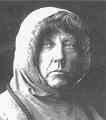 Roald
Amundsen had scarcely returned home from his universally acclaimed
navigation of the North-West Passage on the Gjøa before he began to plan
an expedition to the North Pole. He had a different idea from Fridtjof
Nansen, who had deliberately allowed the FRAM to be frozen into the pack
ice near the New Siberian Islands, on the theory that it would slowly
drift on the Arctic current towards the Pole. Amundsen was convinced that
sailing the Bering Strait would be more effective way of attaining the
same goal - arriving at or near the Magnetic North Pole. Nansen agreed to
lend Amundsen the FRAM, though not before giving the matter considerable
thought.
Roald
Amundsen had scarcely returned home from his universally acclaimed
navigation of the North-West Passage on the Gjøa before he began to plan
an expedition to the North Pole. He had a different idea from Fridtjof
Nansen, who had deliberately allowed the FRAM to be frozen into the pack
ice near the New Siberian Islands, on the theory that it would slowly
drift on the Arctic current towards the Pole. Amundsen was convinced that
sailing the Bering Strait would be more effective way of attaining the
same goal - arriving at or near the Magnetic North Pole. Nansen agreed to
lend Amundsen the FRAM, though not before giving the matter considerable
thought.
The preparations for a second expedition to the North Pole caused bewilderment among the crew on more than one occasion. One source of complexity was Amundsen's luxury “observation” hut, which was to be brought along on the expedition. The seasoned mariners knew that once the structure was positioned on the ice, huge, churning ice blocks were bound to crush it. To the surprise and bewilderment of the crew, 97 Greenland dogs were loaded which were to make the long journey across the Equator and round South America and to bring to the Bering Strait, where the voyage to the Pole would finally commence in earnestness. Why, the men wanted to know, weren't the dogs boarded in Seattle or another American port?
On 2 September 1909, while the FRAM had been undergoing modifications, an extraordinary news story had broken: Frederick Cook claimed to have reached the North Pole on 21 April 1908. Only four days later, on 6 September, a second sensational story had made the headlines:
Admiral Peary had reached the North Pole on 6 April 1909, just a year after Dr. Cook. For Amundsen's considerations the time had now arrived for some tough decisions. A voyage to the North Pole was no longer of burning interest, making the work of raising funds still more difficult. Additionally, Amundsen was already deeply in debt in the aftermath of the Gjøa expedition. On 13 September 1909 Captain Scott informs the London Times that he planned a new expedition to the South Pole, who was till that time still undiscovered ………….
It was at this point that Amundsen decided on a radical change of plans. He was already inspired by Shackleton's attempt to reach the South Pole and he now chose definitive for a new destination: the South Pole. Till this moment the race to the South Pole was only in Amundsen's head going on. He confided his brother, who also acted as his secretary, and the ship's officers about the FRAM's new destination. The ship departed from Norway on 9 August 1910 and reached Funchal on Madeira's southern coast in September, while the world (and his crew) thought he was making for the Arctic. Here he unrolled a map tacked onto the foremast which to everyone's astonishment was of the southern hemisphere. A short briefing followed on the expedition's expanded plans: before conquering the North Pole, it was first to head for the South Pole. Finally the crew had an explanation for everything that had caused bewilderment during the preparations for the expedition - the hut, the boarding of the dogs and sundry other perplexing details.
The expedition's changed objectives required skilful handling of the information which would have to be communicated first to His Majesty the King, and then to Fridtjof Nansen. Subsequently, a telegram was also sent to Captain Robert Falcon Scott onboard “Terra Nova” telling him of on the expedition's revised plans. Now the press was informed. In England the reaction to Amundsen's expanded plans ranged from condescension about his changes of success to pure outrage in some circles. But now the race was on.
The Bay of Wales became FRAM's destination. This is the closest one can get to the South Pole by sea and it was a suitable place to make landfall on the Barrier. The Barrier, also called Shelf, is a nearly permanently frozen sea some two million sq.km. in area. During a stormy passage through the “Roaring Forties”, FRAM proved itself to be a highly seaworthy vessel in the roughest of conditions. On 14 January 1911 the Barrier was reached and roughly 4 km. from the landing site Framheim (Amundsen's hut) was erected and ready for occupancy. Around Framheim they pitched 16-man tents, 14 in all, for the dogs and storage. A small village had taken place. FRAM left the Barrier on 15 February, to sail as far south as possible, thus becoming the ship that had reached both farthest south and farthest north. She and her crew, now reduced to 10 men, then headed for Buenos Aires.
Now the two expeditions were almost ready to begin their assault on the South Pole, and the situation may be summarized as follows:
|
Roald Amundsen |
Captain Robert Falcon Scott |
|||||
| Framheim base 1250 km from the Pole; | Base at McMurdo Sound 1400 km from the Pole; | |||||
| Expected to meet obstacles in the Transantartic Alps; | Followed the track which had already been laid out by Shackleton; | |||||
| Strategy based on the use of dogs and lightweight sledges, also by eating the dogs; | Strategy based on the use of ponies, motorised sledges, dogs and man-haulage; | |||||
| Outfitting based upon the traditional dress of the Inuit people; | Provided with clothes made of ordinary wool cloth; | |||||
| Provisions on the basis of experience gained during the first and second FRAM expeditions; | Scott first began to think about the sledging rations 2 months before setting off, in spite of the fact that scurvy had ravaged the crew. He instructed one of his men to read up on sledging rations in the books available on board; | |||||
| Different lifestyle: nine men shared the same room; | Different lifestyle: 25 men were quartered in two rooms, and the officers and men were separated; | |||||
| Returned to base after first attempt, left base on 20 October for final attempt; | Left base on 24 October; | |||||
| Made 7 depots on the Barrier, marked with great care. | Made 2 depots on the Barrier, poorly marked and insufficient stored ! |
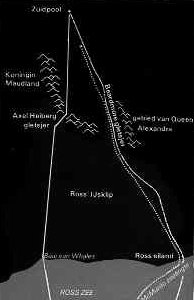 On
15 December, or rather 14 December since they had passed the dateline, and
after carefully avoiding Scott's planned route, Amundsen, Bjaaland, Hassel,
Hanssen and Wisting reached the Geographical South Pole.
On
15 December, or rather 14 December since they had passed the dateline, and
after carefully avoiding Scott's planned route, Amundsen, Bjaaland, Hassel,
Hanssen and Wisting reached the Geographical South Pole. 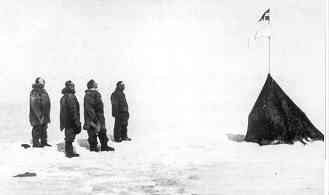 They
erected a small, grey-brown canvas tent. Fastened to the tent pole was a
Norwegian flag and under it an ensign on which was painted the name FRAM.
They
erected a small, grey-brown canvas tent. Fastened to the tent pole was a
Norwegian flag and under it an ensign on which was painted the name FRAM.
A bag was deposited in the tent containing a letter for HM the King detailing their achievements and a short letter to Scott, who Amundsen supposed would be the first to find the site. The place was christened Polheim.. They started back to base on 18 (17) December and reached Framheim on 26 January 1912, after an absence of 99 days.
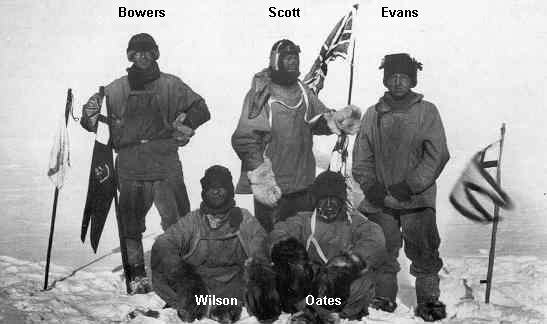 5
days after Scott's departure the motorized sledges were abandoned and immobilized.
But there was more setback. Scott's tent was unsuitable, there was no fur
clothing, the ponies needed special fodder and found it difficult to make
their way in the snow. The party's skiing abilities were poor, and there
was only one set of snowshoes for the ponies, all off which impended their
progress. At the distance of 730 km. from the Pole they had to shot their
last pony, so only manpower was left. On 17 January, 34 days after
Amundsen, a rather dispirited Scott found the Norwegian tent on the South
Pole. On the way back a great deal of time was wasted finding their own
tracks, who were never marked (as Amundsen did), and which had been
covered up by snow drifts
5
days after Scott's departure the motorized sledges were abandoned and immobilized.
But there was more setback. Scott's tent was unsuitable, there was no fur
clothing, the ponies needed special fodder and found it difficult to make
their way in the snow. The party's skiing abilities were poor, and there
was only one set of snowshoes for the ponies, all off which impended their
progress. At the distance of 730 km. from the Pole they had to shot their
last pony, so only manpower was left. On 17 January, 34 days after
Amundsen, a rather dispirited Scott found the Norwegian tent on the South
Pole. On the way back a great deal of time was wasted finding their own
tracks, who were never marked (as Amundsen did), and which had been
covered up by snow drifts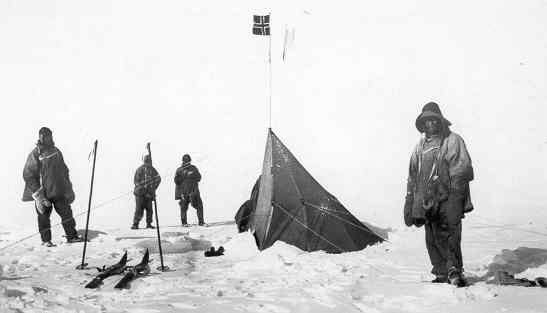 . 550 km. from their base the first man (of five)
died. He was totally weakened, but probably also suffered from scurvy. The
depots they made on the way to the Pole were under stocked so that the
party was short of food and fuel, and their clothes were unsuitable for
the harsh conditions, with temperatures down to minus 30 to 40 ºC. The
suffered from frost-bitten feet and gangrene had begun to set in. 240 km
from base camp they weren't capable to move on and finally died in their
tent. By the end of that year the tragedy was discovered by a search
party.
. 550 km. from their base the first man (of five)
died. He was totally weakened, but probably also suffered from scurvy. The
depots they made on the way to the Pole were under stocked so that the
party was short of food and fuel, and their clothes were unsuitable for
the harsh conditions, with temperatures down to minus 30 to 40 ºC. The
suffered from frost-bitten feet and gangrene had begun to set in. 240 km
from base camp they weren't capable to move on and finally died in their
tent. By the end of that year the tragedy was discovered by a search
party.
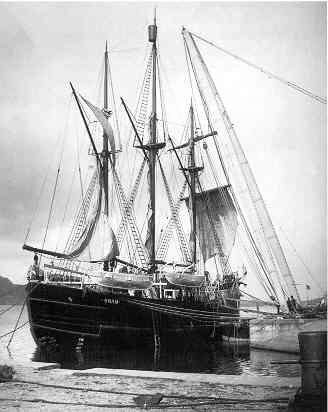 The FRAM reached Buenos
Aires on 25 May 1912. Amundsen received a telegram that the FRAM could be
one of the first ships to pass through the Panama Canal. The vessel was
sailed to Colon, where it was docked from 3 October till 1 December 1913.
The exact date for opening of the canal was still not set, so the FRAM was
ordered to sail southwards and around Cape Horn, then northwards to San
Francisco. When it arrived at Buenos Aires again after its 100-day
journey, the FRAM badly needed an overhauling, as it had sustained damage
during its passage through the tropics. In 1914, Captain Nilsen, who had
taken over as skipper again, was ordered to sail FRAM to Horten. And the
FRAM's day as an active Polar schooner came to an end.
The FRAM reached Buenos
Aires on 25 May 1912. Amundsen received a telegram that the FRAM could be
one of the first ships to pass through the Panama Canal. The vessel was
sailed to Colon, where it was docked from 3 October till 1 December 1913.
The exact date for opening of the canal was still not set, so the FRAM was
ordered to sail southwards and around Cape Horn, then northwards to San
Francisco. When it arrived at Buenos Aires again after its 100-day
journey, the FRAM badly needed an overhauling, as it had sustained damage
during its passage through the tropics. In 1914, Captain Nilsen, who had
taken over as skipper again, was ordered to sail FRAM to Horten. And the
FRAM's day as an active Polar schooner came to an end.
Otto Sverdrup became the first chairman of the Committee to Preserve the Polar Ship FRAM. It is mainly thanks to him that the FRAM was saved from condemnation and break-up. He took the matter up with the authorities and led the way in the effort to restore her. He spent the winter of 1929 and spring 1930 in Larvik to supervise the FRAM's restoration.
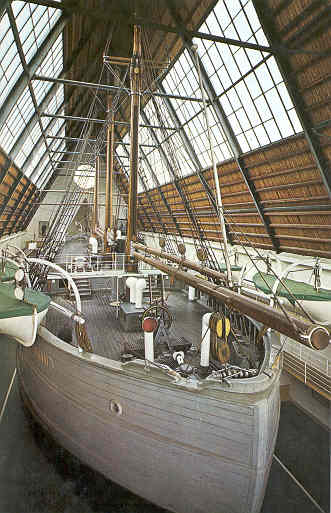 Today the FRAM is preserved
as a national monument in a building specially constructed for her near
Oslo, known as the FRAM Museum. Walking on her deck and sitting in the
saloon, with all the historic pictures, objects and paintings, you can
still feel the heroic atmosphere and hear the cracking and creaking sound
of the ice. There are also other comprehensive stories about Arctic
expeditions and the complete story of Roald Amundsen, being told by
pictures, the used materials and objects and the outside the building
exposed Gjøa.
Today the FRAM is preserved
as a national monument in a building specially constructed for her near
Oslo, known as the FRAM Museum. Walking on her deck and sitting in the
saloon, with all the historic pictures, objects and paintings, you can
still feel the heroic atmosphere and hear the cracking and creaking sound
of the ice. There are also other comprehensive stories about Arctic
expeditions and the complete story of Roald Amundsen, being told by
pictures, the used materials and objects and the outside the building
exposed Gjøa.
